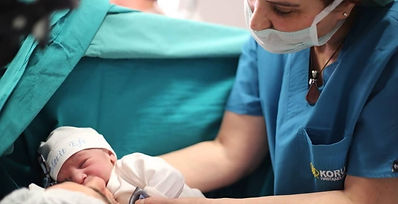Gynecology and obstetrics:
A doctor who specializes in a branch of medicine that deals with women's reproductive health and generally diagnoses, treats, or prevents problems with women's reproductive organs. These specialists are also commonly known as gynecologists.
Gynecologists and obstetricians have expertise in subjects such as pregnancy follow-up, birth, birth control, gynecological cancer screening, sexual health, menstrual irregularities, infertility. They can also manage conditions that require gynecological surgery.

> In Vitro Fertilization Treatment
Tup baby treatment is one of the reproductive technologies in the field of medicine andIt is used to increase the chances of having children.
In vitro fertilization, It is also known scientifically as in vitro fertilization (IVF). Essentially, this treatment involves combining the woman's eggs with sperm to fertilize them and implanting the resulting embryo into the uterus.
Here are the basic stages of in vitro fertilization treatment:
-
Egg Stimulation (Ovarian Stimulation): The woman's natural ovulation cycle is stimulated with medications for the development of more than one egg. This aims to obtain many eggs during treatment.
-
Egg Collection (Oocyte Aspiration): Matured eggs are collected through a needle.It is collected from the ovaries. This procedure is usually performed under ultrasound guidance.
-
Sperm Provision: Sperm samples taken from the man are prepared and the best quality sperm cells are selected.
-
Fertilization: Fertilization is achieved by bringing together the collected eggs and selected sperm cells. Fertilized eggs are called embryos.
-
Embryo Culture: Fertilized eggs are cultured in a laboratory environment for a certain period of time, cell divisions are monitored and embryos are formed.
-
Transfer: The best quality embryos are selected to be placed in the uterus and the transfer process is performed. This provides a chance for the embryo to attach to the uterus.
-
Pregnancy Test: A pregnancy test is performed to determine whether the embryo has successfully implanted in the uterus.
In vitro fertilization treatment can help couples solve fertility problems, depending on a variety of factors. However, every couple's situation is different and treatment success is not guaranteed. It is important for couples to consult a specialist doctor before starting an in vitro fertilization treatment process.
Your Health, Our Expertise!

> Genital Aesthetics
GeNital aesthetic treatment can be defined as a category that includes surgical or non-surgical procedures aimed at correcting or improving the aesthetics of the genital area.
Such treatments can offer a variety of options for individuals who are uncomfortable for aesthetic or functional reasons.
Genital aesthetic treatments may include the following procedures:
-
Labioplasty: Labioplasty involves surgical correction or reshaping of the female genital labia minora (inside the lips) or labia majora (outside the lips) tissue. This procedure may be performed to address size, shape or symmetry problems of the labia lips.
-
Vaginoplasty: Vaginoplasty is a surgical procedure that aims to increase the tightness of vaginal tissues. It can generally be applied to correct loosening after birth or loosening that occurs during the aging process.
-
Mons Pubis Liposuction: Liposuction can be used to reduce fat accumulation in the mons pubis area. This is done to improve the aesthetics of the genital area and provide a more aesthetic appearance.
-
G-Spot Amplification: G-spot amplification involves injecting filler into the G-spot area inside the vagina to increase sexual arousal and orgasm.
-
Prepubertal Labioplasty: In children, labiaplasty is a procedure that should generally be considered after puberty. Surgical intervention may often be considered for individuals experiencing discomfort or problems after puberty.
Genital aesthetic treatments vary depending on the individual's uniqueness and personal preferences. However, it is important to consult a specialist doctor regarding the necessity and appropriateness of such procedures.
With You for a Healthy Tomorrow!

> Sexual Desirescar
KaTreatment of sexual reluctance in external diseases, decreased sexual desire in womenIt aims to address health problems associated with or deficiency.
This condition can often occur due to physical, hormonal, psychological or relational factors. Treatment aims to improve a woman's sexual health and satisfaction by taking an approach that addresses the underlying causes.
Here are the basic elements for the treatment of sexual reluctance in gynecological diseases:
-
Physical Examination and Laboratory Tests: A health professional can evaluate the woman's general health condition to identify physical causes of sexual reluctance. Hormonal imbalances, thyroid issues, or other health problems may be addressed during this process.
-
Hormonal Treatments: Hormonal changes, especially during menopause, can cause lack of sexual desire. Hormone replacement therapy or other methods of maintaining hormonal balance may be used to increase sexual desire.
-
Psychological Counseling and Therapy: Psychological factors can have an impact on women's sexual reluctance. A psychologist or sexual therapist can provide treatment by focusing on psychological factors such as past experiences, stress, anxiety or depression.
-
Sexual Education and Counseling: By receiving sexual education and counseling, women can learn about their sexuality and develop habits that promote healthy sexual function.
-
Drug Treatment: There are medications used for sexual reluctance, especially due to hormonal factors. However, drug therapy may not be suitable for everyone and should be managed with a doctor's prescription.
-
Couples Therapy: Relational problems can trigger sexual reluctance. In this case, couples therapy can help the couple improve their communication and understand each other.
Every woman's situation is different, so the treatment plan is often individualized. It is important to consult with a healthcare professional to determine underlying causes and consider appropriate treatment options.
We are with you at every moment, from birth to menopause!
> Pregnancy Tracking
Gebhealth monitoring, a woman's health during pregnancy and the development of her baby to monitor, recognize potential problems and provide necessary interventions.It refers to the process that includes a series of medical and other measures taken.
Pregnancy tracking, It aims to optimize the health of both mother and baby and continues from the beginning of pregnancy until birth.
Pregnancy tracking usually includes these elements:
-
Pregnancy Test and Diagnosis: When pregnancy symptoms appear or the menstrual cycle is delayed, a pregnancy test is performed. When a woman finds out she is pregnant, her healthcare professional is contacted and a pregnancy diagnosis is made.
-
Prenatal Care Appointments: Throughout pregnancy, the expectant mother should attend prenatal care appointments at regular intervals. These appointments are performed by healthcare professionals to evaluate the health of the mother and baby, monitor developments, and identify potential problems.
-
Ultrasound and Developmental Monitoring: Ultrasonography is used to provide the baby's size, organ development, and other important information. These imaging tests play an important role in the baby's health and prenatal diagnosis.
-
Blood Tests and Genetic Screening: Various blood tests and genetic screenings can be performed during pregnancy. These tests can be helpful in identifying potential genetic disorders or other health problems.
-
Nutrition and Exercise Consultancy: Provides guidance to the expectant mother to support pregnancy follow-up, healthy nutrition and regular exercise habits.
-
Routine Medication and Vaccine Checks: Medications and vaccines that are safe for pregnant women are reviewed. If necessary, appropriate medications are prescribed or vaccinations are administered.
-
Birth Planning and Preparation: Pregnancy follow-up also includes the process of determining the birth plan and preparing the expectant mother for birth. This is an important stage to focus on in the final months before birth.
Pregnancy monitoring should be tailored to the individual needs and risk factors for each pregnancy. This process is important for managing pregnancy and birth in a healthy way and can help maximize the health of the mother and baby.
Your Health is Safe with Us for You and Your Future!
> Infertility Treatment
ThatConfidentiality treatment includes medical intervention and treatment methods applied in cases where couples are not successful in their efforts to achieve pregnancy.r.
Infertility treatment in gynecological diseases generally focuses on problems related to the reproductive system and tries to address the factors that prevent couples from getting pregnant naturally. Infertility treatment varies depending on the underlying causes and is planned specifically for the couple's situation.
Infertility treatment in gynecological diseases may include the following basic elements:
-
Ovulation Induction: If the woman does not produce eggs regularly, medications called ovulation induction can be used. These medications can help increase ovulation.
-
Evaluation of Ovarian Reserve: A woman's ovarian reserve can be evaluated when planning infertility treatment. This includes blood tests and ultrasound examinations to determine egg reserve.
-
Intrauterine Egg Fertilization (IUI): IUI is a procedure in which sperm are placed directly into the uterus. This can make it easier for sperm and egg to come together.
-
In Vitro Fertilization (IVF): IVF involves fertilizing a woman's eggs with sperm in a laboratory environment. Fertilized eggs become embryos and the best quality embryos are transferred to the uterus.
-
Intrauterine Egg Fertilization (ICSI): ICSI is an IVF procedure in which a sperm cell directly fertilizes an egg. This can be used in cases where the number of sperm cells is low.
-
Egg Donation or Surrogacy: Egg donation or surrogacy options may be considered for women who have difficulty achieving pregnancy due to egg or uterine problems.
-
Surgical Interventions, Such as Endometriosis or Uterine Fibroids: If there are anatomical problems caused by underlying diseases, surgical interventions (for example, surgery for endometriosis or uterine fibroids) may be considered.
Infertility treatment varies depending on each couple's situation, and a personalized treatment plan is created by taking into account the couple's medical history, age, underlying causes and other factors. These treatments offer couples a variety of options to increase their chances of achieving pregnancy.
Dedication to Women's Health is Building the Future!

> Vaginismus Treatment
vaginaNismus is a condition in which women experience an involuntary and uncontrollable muscle spasm or contraction in response to intervention in the genital area.
This condition is characterized by pain and discomfort during sexual intercourse, gynecological examinations, or vaginal medical procedures. Vaginismus can cause problems in sexual health and sexual intercourse and can negatively affect the sexual lives of couples.
Vaginismus treatment often requires a multidisciplinary approach and may include these key elements:
-
Psychosexual Therapy: This involves talking about a person's sexual history, perceptions, and emotional state, under the guidance of a therapist or sexual health professional. It is used to understand and resolve an individual's negative thoughts and emotional blockages regarding sexuality.
-
Pelvic Floor Physiotherapy: It includes exercises performed under the guidance of a physiotherapist to strengthen and relax the pelvic floor muscles. This can address the physical aspects of vaginismus.
-
Sexual Education and Information: Providing information about sexuality to the individual and his/her partner, providing accurate anatomical information and education on sexual health can be part of the treatment.
-
Conceptual Awareness and Mindfulness Practices: Mindfulness and conceptual awareness techniques can be used to understand and try to control the person's relationship with his body and sexual arousal.
-
Exercises at Home: Individuals can learn strategies such as relaxation and breathing techniques that they can apply at home to cope with their anxiety and fears about sexual intercourse.
Vaginismus treatment varies depending on individual needs and situation. It is important for couples to have open communication, be patient and work together during the treatment process. Starting treatment early and progressing under the guidance of an expert healthcare professional can increase the chances of success.
A Strong, Healthy and Happy Future for Life!

> Abortion Treatment
KAbortion is a general name given to surgical or drug interventions to terminate pregnancy. Abortion may be an option for women who do not want a pregnancy or cannot continue it for health reasons.
Since abortion is a medical procedure, it should be performed under appropriate conditions and by healthcare professionals.
Abortion treatment can be performed in two basic types:
-
Surgical Abortion (Aspiration or Curettage): Surgical abortion is a procedure usually performed under local anesthesia or general anesthesia. The uterine contents are removed using surgical instruments or vacuum. Aspiration curettage and curettage (scraping) methods fall into this category.
-
Medication Abortion (Medical Abortion): Medication abortion aims to terminate the pregnancy through the use of certain medications. First, a medicine called Mifepristone is taken. Then, a few days later, another medicine called Misoprostol is used. These drugs help thin the lining of the uterus and terminate the pregnancy.
The decision to have an abortion varies depending on a woman's personal, moral and health circumstances. Abortion involves a number of factors about a woman's sexual and reproductive health. Legal and ethical issues, the policies of the health institution where the abortion will be performed, and the country's abortion regulations also play an important role.
Open communication and counseling with a healthcare professional before and after an abortion is important. This can help the woman feel informed and supported in her decision-making process.
Every Moment is Precious, Every Birth is a Miracle!

> Birth Processes
Birth means the completion of the development process of a living thing in the womb and coming out of the mother's body and coming to the world.
For humans, birth usually involves the expulsion of a baby, placenta, and other birthing material through contractions of the mother's uterus and often through the vagina.
Birth involves a series of complex biological processes and generally consists of three stages:
-
First Phase (Expansion Phase): Irregular contractions of the uterus begin and the cervix begins to expand. This phase can usually last a few hours in women who have not given birth before, and shorter in women who have given birth before.
-
Second Phase (Pushing Phase): After the cervix is fully dilated, the second phase begins. During this stage, the mother pushes and the baby is born through the vagina.
-
Third Stage (Placenta Stage): After the baby is born, the placenta and other birth materials are expelled through the vagina. This stage usually occurs shortly after birth.
Birth is usually a natural process, but sometimes medical intervention may be required. These interventions may include methods such as epidural anesthesia, use of vacuum or forceps, and cesarean delivery.
Birth is an important event for mother and baby and is usually managed by a healthcare professional (obstetrician or midwife). Additionally, a birth team may be involved to monitor the health of the mother and baby before and after birth, to assess their health status, and to provide medical interventions if necessary. Birth is a different experience for each individual and each pregnancy.nabilir.






